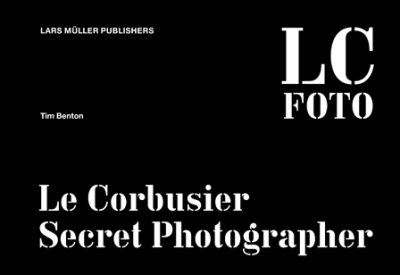
Le Corbusier Secret Photographer (LC FOTO)
In Le Corbusier: Secret Photographer Tim Benton reflects on the famous architect’s use of photography, starting with the young Charles-Edouard Jeanneret’s attempts to take professional photographs during his travels in central Europe, the Balkans, Turkey, Greece, and Italy. While Le Corbusier always claimed that he saw no virtue in taking photographs, he actually bought three cameras and took several hundred photographs between 1907 and 1917, many of them of publishable quality. In 1936 he acquired a 16mm movie camera and took 120 sequences of film and nearly 6,000 photographs with it.
This previously unpublished material is the basis for the publication. It reveals Le Corbusier to be a sensitive and brilliant manipulator of a wide range of photographic styles. Le Corbusier: Secret Photographer provides dramatically new insights into Le Corbusier’s visual imagination, his changing attitudes towards nature and materials in the 1930s, and his distrust of progress.
In LC FOTO: Le Corbusier Secret Photographer untersucht Tim Benton, wie der berühmte Architekt die Fotografie verwendet hat, angefangen bei den Versuchen des jungen Charles-Edouard Jeanneret, während seiner Reisen durch Mitteleuropa, den Balkan, die Türkei, Griechenland und Italien professionelle Aufnahmen zu machen. Auch wenn Le Corbusier stets behauptete, der Fotografie keinen grossen Wert beizumessen, erwarb er doch zwischen 1907 und 1917 drei Fotokameras und machte damit hunderte von Aufnahmen, viele davon in hoher Qualität. 1936 kaufte er eine 16mm-Filmkamera, mit der er 120 Filmsequenzen sowie fast 6000 Fotoaufnahmen machte.
Teile aus diesem kaum der Öffentlichkeit bekannten Material bilden das Herzstück der Publikation. Sie zeigen ihn als sensiblen und brillanten Arrangeur einer grossen Bandbreite fotografischer Stile. LC FOTO: Le Corbusier Secret Photographer bietet einzigartige neue Einsichten in Le Corbusiers visuelles Imaginationsvermögen, seine sich ändernden Ansichten zur Natur und neuen Materialien in den 1930er-Jahren wie auch zu seiner Fortschritts-Skepsis.
24 x 16,5 cm, 416 Seiten, 970 Abbildungen, Hardcover (2013)

































































































